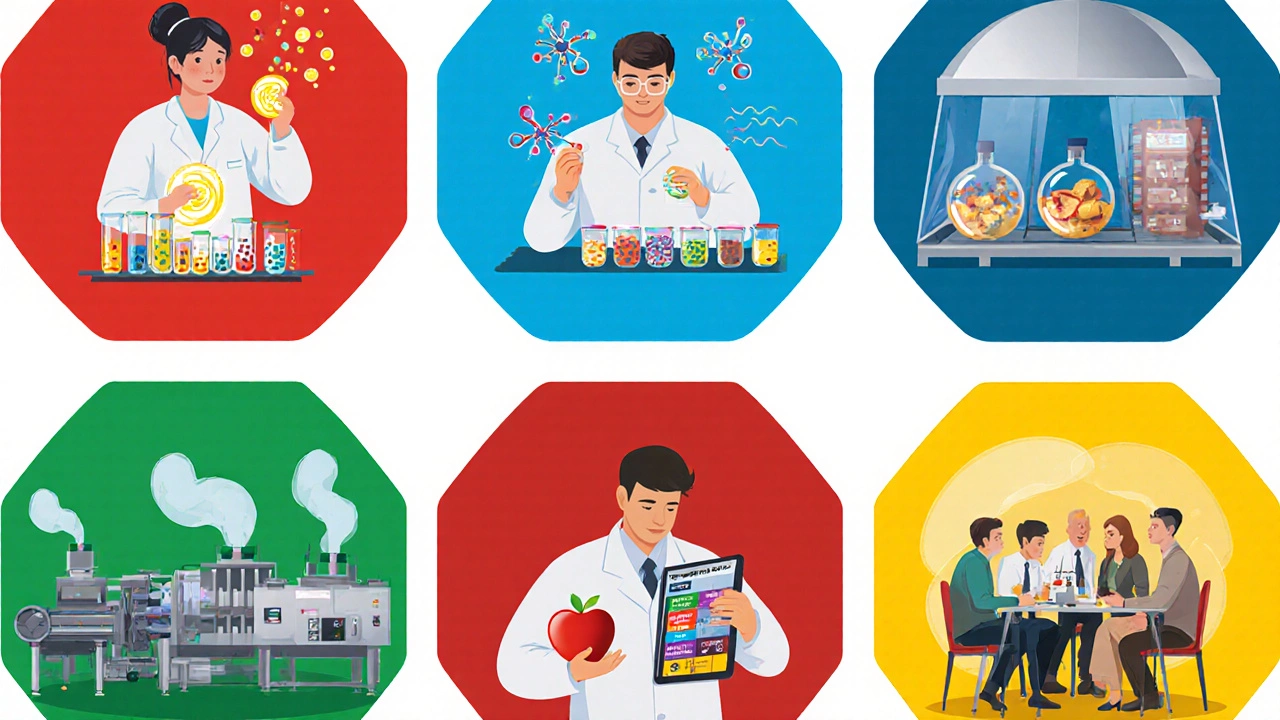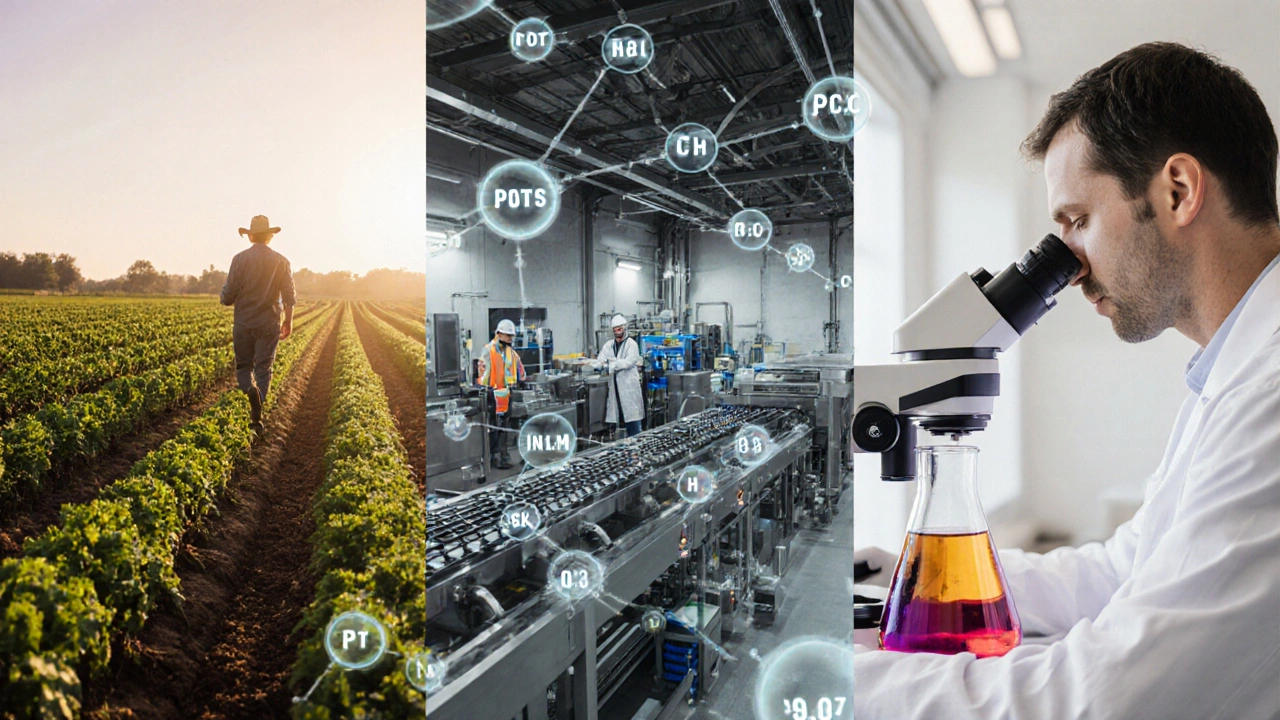When you wonder "What is the food science called?" you’re actually looking for the umbrella discipline that links farms, factories, and kitchens. Food Science is the study of the physical, biological, and chemical makeup of food, and the concepts used to improve it. It pulls together chemistry, microbiology, engineering, and nutrition to turn raw ingredients into safe, tasty, and nutritious products.
Origins and Scope of Food Science
Food Science emerged in the early 20th century as a response to industrial‑scale food production. Researchers realized that simply cooking or canning wasn’t enough; they needed scientific methods to extend shelf life, enhance flavor, and prevent spoilage. Today the field spans everything from developing plant‑based proteins to designing smart packaging that reacts to temperature changes.
Key Sub‑disciplines
Within the broader umbrella, several specialized branches tackle distinct challenges:
- Food Chemistry focuses on the molecular composition of foods-proteins, fats, carbohydrates, vitamins, and how they interact during processing.
- Food Microbiology studies microorganisms that can either spoil food or make it safer (think fermentation).
- Food Engineering applies principles of heat transfer, fluid dynamics, and equipment design to scale recipes from a kitchen to a factory.
- Food Safety ensures that every step-farm, transport, processing-meets health standards and regulatory limits.
- Nutrition evaluates the health impact of foods and helps formulate products that meet dietary guidelines.
- Sensory Analysis uses trained panels to measure taste, aroma, texture, and visual appeal.
- Food Packaging designs containers that protect, preserve, and communicate product information.
Food Science vs. Food Technology vs. Food Engineering
Although the terms overlap, each carries a distinct emphasis. The table below distills the core differences.
| Aspect | Food Science | Food Technology | Food Engineering |
|---|---|---|---|
| Primary Focus | Understanding food’s composition and behavior | Applying scientific findings to develop products | Designing equipment and processes for large‑scale production |
| Core Disciplines | Chemistry, Microbiology, Nutrition | Product development, Quality control | Thermodynamics, Fluid mechanics, Materials science |
| Typical Careers | Research scientist, Food chemist | Product developer, Quality manager | Process engineer, Equipment designer |
| Key Outputs | Scientific insights, New food ingredients | Ready‑to‑market foods, Shelf‑life studies | Scaled‑up production lines, Automation solutions |

Career Paths in Food Science
Graduates can move into many roles, depending on their specialization:
- Research & Development (R&D): Create novel products, improve existing recipes, test functional ingredients.
- Quality Assurance/Control: Monitor batch consistency, enforce safety standards, conduct HACCP audits.
- Regulatory Affairs: Navigate food laws (FDA, EFSA, FSANZ), prepare labeling, ensure compliance.
- Process Engineering: Scale processes, reduce waste, optimize energy use in factories.
- Sensory Evaluation: Lead tasting panels, translate consumer feedback into product tweaks.
Salary ranges vary: entry‑level analysts earn around NZ$55,000 - $70,000, while senior engineers and R&D managers can exceed NZ$120,000.
Real‑World Applications
Some everyday examples showcase how food science solves problems:
- Extended Shelf Life: Modified atmosphere packaging (MAP) slows microbial growth, keeping salads fresh for up to two weeks.
- Plant‑Based Meat: Texturized vegetable proteins mimic animal texture thanks to protein extrusion technology.
- Food Fortification: Adding iodine to salt or vitamin D to milk combats nutrient deficiencies.
- Flavor Enhancement: Umami‑rich nucleotides boost taste without extra salt, helping meet health guidelines.
Education and Resources
To get started, look for degree programs titled “Food Science,” “Food Technology,” or “Food Engineering.” In New Zealand, universities such as Massey and the University of Waikato offer accredited courses. Professional bodies-Institute of Food Science & Technology (IFST) and the New Zealand Food Safety Authority-provide certifications and continuing‑education webinars.

Common Misconceptions
People often mix up food science with cooking. While chefs apply culinary art, food scientists rely on data, lab tests, and engineering principles. Another myth is that food science is only about “food additives.” In reality, the field also tackles sustainability, waste reduction, and the development of alternative proteins.
Future Trends to Watch
Three big movements will shape the next decade:
- Digital Twins: Virtual models of processing plants allow engineers to test changes without stopping production.
- Personalized Nutrition: AI analyzes individual biomarkers to suggest tailored food formulations.
- Circular Food Systems: Up‑cycling food waste into ingredients (e.g., fruit pomace flour) reduces environmental impact.
Staying ahead means blending traditional lab skills with data analytics and sustainability mindset.
Frequently Asked Questions
Is Food Science the same as Food Technology?
No. Food Science is the broader study of food’s composition and behavior. Food Technology takes those insights and applies them to create marketable products.
What jobs can a Food Science graduate get?
Typical roles include research scientist, quality assurance manager, process engineer, regulatory affairs specialist, and sensory analyst.
Do I need a chemistry background to study Food Science?
A solid foundation in chemistry helps, but many programs also emphasize biology, engineering, and nutrition, offering interdisciplinary coursework.
How does Food Engineering differ from Mechanical Engineering?
Food Engineering focuses on processing edible materials, considering factors like food safety, shelf life, and sensory quality, whereas Mechanical Engineering deals with broader mechanical systems without those food‑specific constraints.
What is the role of Food Microbiology in product safety?
Food Microbiology identifies harmful bacteria, yeasts, and molds, and designs preservation methods (e.g., pasteurization, acidification) to keep foods safe throughout their shelf life.
Understanding the terminology-Food Science, Food Technology, Food Engineering-helps you navigate education choices, career paths, and industry trends. Whether you’re curious about why a snack stays crunchy for months or you aim to design the next plant‑based burger, the answer lies in the science that turns raw ingredients into the food we eat every day.
